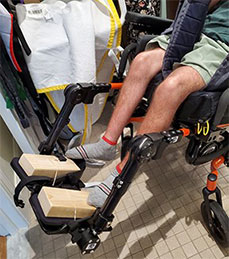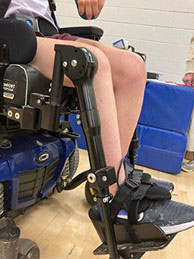Newly Designed Dynamic Footrests! It’s all about the Pivot Point!
Greg Peek, President and Michelle L. Lange, OTR/L, ABDA, ATP/SMS
Dynamic Seating components are designed to move with a client. A great deal of design goes into these components to ensure the product responds to client forces and maintains client position. The Seating Dynamics Dynamic Footrests provide movement in 3 areas: a downward, telescoping movement; knee extension; and ankle plantar/dorsiflexion. Combined, these movements are designed to follow the natural arc of movement when the leg extends.
Capturing Complex Movements
This is a challenging movement pattern to capture as the client may use a unique combination of hip, knee, and ankle extension with possible hip abduction or adduction, as well as rotation. Movement may differ on each side of the body and may not be consistent in force, degree, or direction throughout the day.
Pivot Points – the problem
A key design feature is the Dynamic Footrest pivot point which provides knee extension. In order to readily and successfully respond to client extension, the pivot point needs to be as close to the knee as possible. We have noticed that in many circumstances, the pivot point was too low. Seating Dynamics has offered a High Pivot option for many years to raise the pivot point of the Dynamic Footrest. This was originally designed for clients with short lower leg lengths (i.e., kids) and for when the seating surface was particularly high. However, we now realized that this option needed to become standard in order to better match the natural pivot point of the knee.
In designing the product in 2012, I (Greg) realized that there would be misalignment between the knee and the pivot point but thought that, between the elevation and telescoping movements, it would be OK. Having seen a number of photos of actual installations since then, I have learned that it is not OK and should not be used in most cases. A clear example is Figure 1 in which we see many issues in need of correction. If the footrest pivot is not closely aligned with the knee pivot point (which is about two inches above the Popliteal Fossa), full functionality of the dynamic footrest is not provided. As a result, we have a newly designed Dynamic Footrest!
Let’s take a look at the problem:

Figure 1: The Dynamic Footrests are too low and too far forward of the knee The footplates also need to be raised.

Figure 2: This is an example of an appropriately mounted dynamic footrest, using a High Pivot option.
Our new redesign addresses these issues. The pivot point is raised, height adjustable, and streamlined to minimize the overall size.
Thanks for your continued support as we strive to keep making our product solutions work even better for clients using wheelchairs!
